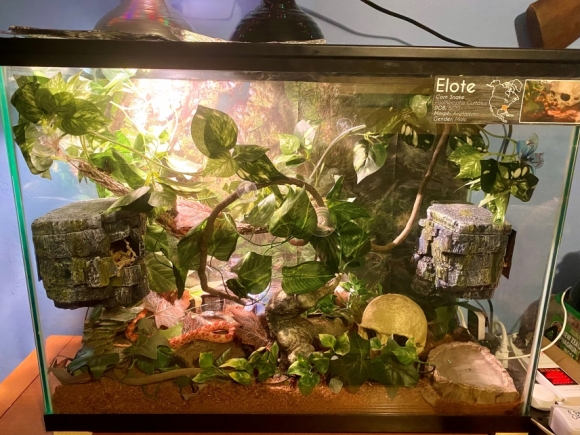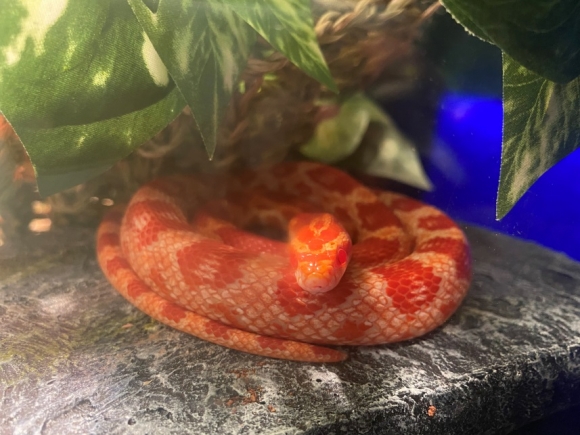


ASK US
Corn Snakes for Beginners
Have you ever envisioned yourself owning a snake? Reptiles can be great pets, but should not be purchased on a whim as they require a great deal of research and specialized care to be healthy and happy. There are endless types of snakes, all requiring different sized enclosures, temperatures, humidity and food sources, so you’ll want to hone in on which species might work best for you and your household. A great “starter” snake is a Corn Snake. These hearty snakes come in a wide range of gorgeous colors and are fairly easy to find through a breeder or local reptile expo.
Corn snakes start out about 8-12 inches long and grow to 4-5 feet in length so will need a fairly large tank size in adulthood. With proper care Corns can live into their late teens or early 20s so this pet comes with a longer term commitment. Corn snakes tend to be very docile snakes, making them great for families or first timers. They are also “easy” to care for with environmental requirements that are a little less stringent than many other snakes and reptiles. Corn snakes eat mice, which are fairly easy to get a hold of in frozen form both from local pet stores and online sources. 
Corn snakes can start out in a fairly small enclosure, but will graduate to at least a 40 gallon (if not more) within a couple of years. Vivariums should have a temperature gradient offering the snake a warm end at around 85 degrees and a cooler side closer to 75 with nighttime temperatures in the upper 60s. They have no specific lighting requirements, although should be offered a light cycle via natural window light or a standard lamp on a timer. Heat sources can vary depending on the temperatures in your home. A simple light on one side of the tank during the day may be enough to provide the proper gradient. If your house gets cold at night you may want to consider a ceramic heat emitter to provide heat without light interference. Some people also use heat mats underneath the warm side of the enclosure to provide heat from below. With all heat sources you will want to use thermostats and regularly check surface temperatures with a thermometer gun to ensure everything is working properly and will not burn your snake.
What is inside your enclosure is also very important. Corns like to burrow so providing a substrate that will allow this is very important. You will also want to choose a substrate appropriate for your home’s humidity level as some promote humidity better than others. Corns do not require high humidity like some snakes so 40-50% should suffice for proper shedding. Temperature and humidity should be monitored with a digital thermometer/hygrometer combo sitting on the substrate on each side of the enclosure.
Once you’ve got your enclosure basics, you can decorate! Snakes love areas to hide in and require at least one hide on each end for temperature choice. Hides can be very simple or more expensive and elaborate. They also like branches to climb, leaves and greenery and even paper towel tubes or egg cartons rotated for enrichment. All items should be reptile appropriate (no sharp edges) and cleaned prior. The enclosure should be spot cleaned each time the snake defecates and should undergo a full cleaning and substrate change every 2-3 months.
Corn snakes eat mice that are sized according to the size of the snake. Live mice can injure a snake so frozen/thawed mice are preferred. Choosing an appropriately sized prey item and feeding schedule is based upon the age, weight and size of the snake. The mouse should be about 1 to 1.5 times the size of the snake’s thickest point. Typically snakes start out eating once weekly, but will go further between feedings as they age. 
Snakes regularly shed their skin as they grow. Just prior to shedding the skin color dulls and eyes may appear blue in color. As long as housing and humidity is appropriate, snakes don’t typically require anything special to shed. If humidity levels are slightly less than ideal you may want to offer a humid hide with dampened spangnum moss or paper towel inside. If a snake sheds, but is left with “stuck shed” it is very important to see your veterinarian to help assist with safe removal and discuss how to prevent this in the future.
Snakes, like any other pet, have their own set of needs to be met. They may require feeding less often, but still require regular cleaning and maintenance, diligent monitoring and veterinary care with vet who is familiar with reptiles. If you take the time to do your research, create a proper habitat and meet the needs of your snake you can have a fascinating pet to observe and enjoy for years to come!



